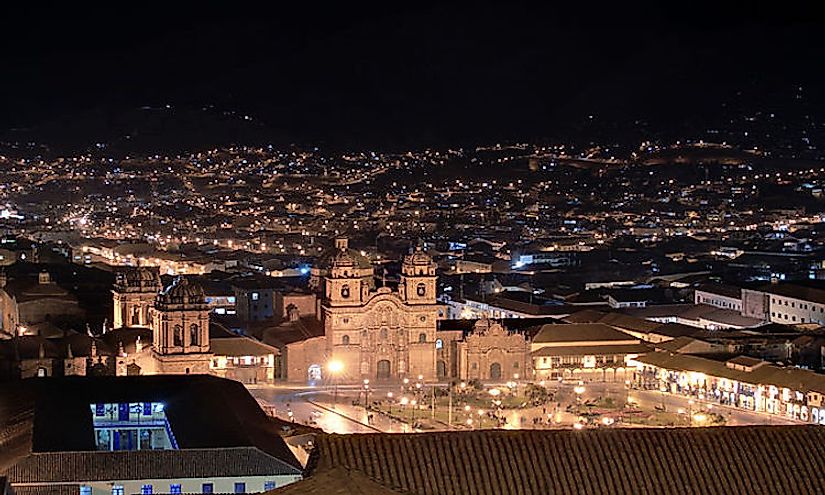UNESCO World Heritage Sites In Peru

Peru contains numerous and diverse archeological sites, each representing different elements of the pre-colonialist times and the culture that existed at the time. Compositions of such sites include temples, fortresses, and residences of the ancient occupants in Peru. UNESCO recognized these sites as having significant cultural importance and declared them World Heritage Sites.
UNESCO World Heritage Sites In Peru
Arequipa Historical Center
The historical center of Arequipa represents the integration of the Western and native building techniques and characteristics. Its buildings contain pink or white volcanic rocks, and distinctive features resulting from natural causes and the historical context. Arequipa resulted from an agricultural valley of the Hispanic community in 1540. The city developed in five distinct periods, starting as a Hispanic settlement village in 1540-1582, baroque splendor 1582-1784, rococo and neoclassicism in 1784-1868, modern empiricism in 1868-1960 and lastly the contemporary design. The center of the historic town is the Plaza Mayor with its entrances, the municipality, and the cathedral. The Monasterio de Santa Catalina is a picturesque religious fortress. The complex of San Francisco and the chapels and convents of Santo Domingo, La Merced San Agustín, and the church of Santa Maria; Santa Teresa and Santa Rosa. The national constitution protects this historical center by the general law for the national cultural heritage of 2004. The supreme resolution and degree declare the center as a monumental area and its buildings with a heritage value. It was declared UNESCO world cultural heritage site in 2000.
Cuzco
Cuzco was an Inca city that developed as a complex urban center of religious and administrative importance. It contains notable buildings which show a stone construction technology with extraordinary artistic and structural properties, such as the Temple of the Sun, the Sunturcancha, the Aqllahuasi the Kusicancha and a series of exquisitely finished buildings that shape the Inca compound. After the Spanish conquest in the 16th century, the Spanish preserved the Inca city of Cuzco, on which they built temples, abbeys, and houses. The Spanish buildings contained the baroque style with local modifications thus displaying a unique and high-quality mixture that presents apposition and fusion of different periods and culture. The city's outstanding fusion is also evident in their artistic expressions. As an imperial city, it retains the granite walls, streets within the walls and the ruins of the temple of the sun and as a colonial city it still holds the elegance of Baroque churches. After the massive earthquakes destroyed parts of the city, preservation measures of reconstruction, a declaration as a monumental area and management plans swung into place. Cuzco was inscribed as a cultural world heritage site in 1983 by UNESCO.
Chan Chan
Chan Chan was the capital center of the Chimu kingdom that fell in the 15th century. The monumental zone contains around nine large rectangular complexes of thick earthen walls decorated with friezes representing abstract patterns, humanlike and cryptic subjects. Within these units, buildings including houses of worship, residences, and storehouses are arranged around wide spaces, together with cisterns, and funeral platforms. Around the citadels were thirty-two compounds and four industrial sectors for activities such as weaving, woodwork, and smelting. The property is frequently affected by adverse climatic conditions like El Ninos and UNESCO named it a world cultural heritage site in danger 1986. The destruction of its property through the construction of roads also threatens the heritage site. Preservation measures include the implementation of corrective actions and development of management plans.
Chavin
Chavin is one of the best-known and earliest archeological sites and represents the most significant expression of the arts and decorative and construction skills of its time. Its culture developed between the 15th and the 5th century BC. Chavin served as a ceremonial and pilgrimage center for Andeans which marked it as an important center of ideological, cultural and religious convergence. The culture of the site is evident in its architectural, technological and symbolic creations characterized by the quarried stone buildings, artificial terraces around the plaza with the internal gallery system. The buildings have decorations of lush humanlike, and cryptic iconography of phenomenal aesthetic synthesis carved on tombstones and monolithic stone sculpturesThe Circular Plaza, Chavin Lanzón, the Tello Obelisk, the Raimondi Stela the Falconidae Portico, the and the tenon heads, and others are appealing building complexes of the city. After the flood partially covered the area, there have been preventative measures, cleaning, and preparation works going on in an attempt to preserve its heritages. The ministry of culture developed a management plan to oversee projects meant for protecting, maintaining and restoring the site. The site was named UNESCO world cultural heritage site in 1985.
Protection Of The National Treasures
The state of Peru recognizes these archeological sites basing on the cultural importance and historical significance. The country’s constitution defines the boundaries and the protection of the sites. The preservation of these heritage sites is in the hands of the ministry of culture which is responsible for the reconstruction and management of the areas. Major threats facing these sites include adverse climatic occurrences like floods and earthquakes, together with human disturbances such as illegal occupancy and construction.
UNESCO World Heritage Sites In Peru
| UNESCO World Heritage Sites in Peru | Year of Inscription; Type |
| Arequipa Historical Center | 2000; Cultural |
| Caral-Supe Sacred City | 2009; Cultural |
| Chan Chan | 1986; Cultural Site in Danger |
| Chavin | 1985; Cultural |
| Cuzco | 1983; Cultural |
| Huascarán National Park | 1985; Natural |
| Lima Historic Center | 1988; Cultural |
| Machu Picchu | 1983; Mixed |
| Manú National Park | 1987; Natural |
| Nasca and Palpa Lines and Geoglyphs | 1994; Cultural |
| Qhapaq Ñan Andean Road System | 2014; Cultural |
| Río Abiseo National Park | 1990; Mixed |







